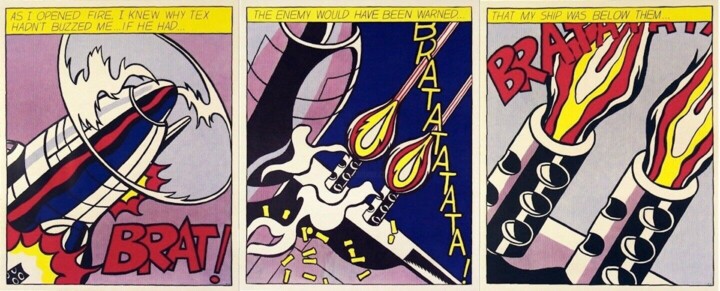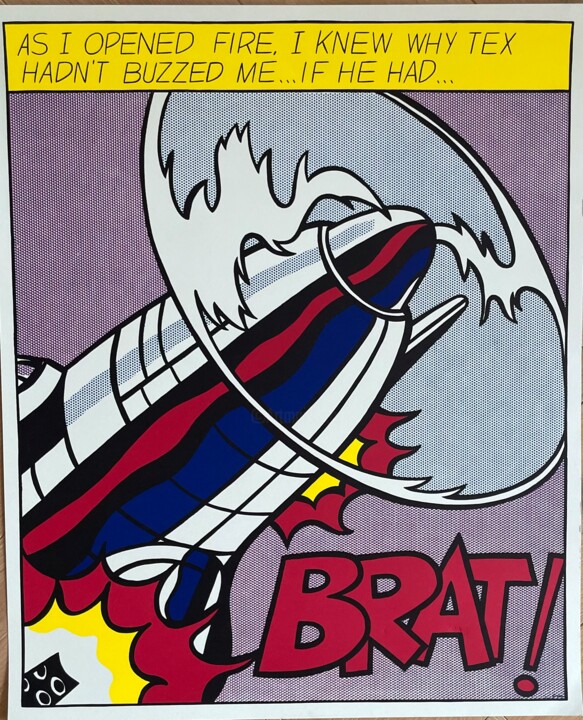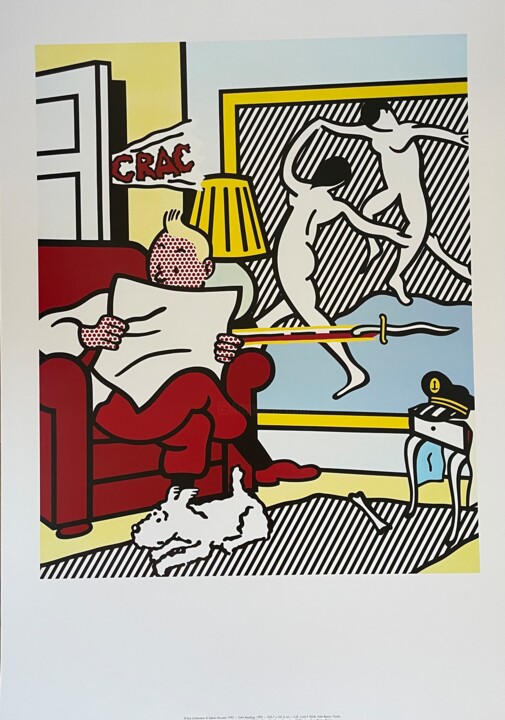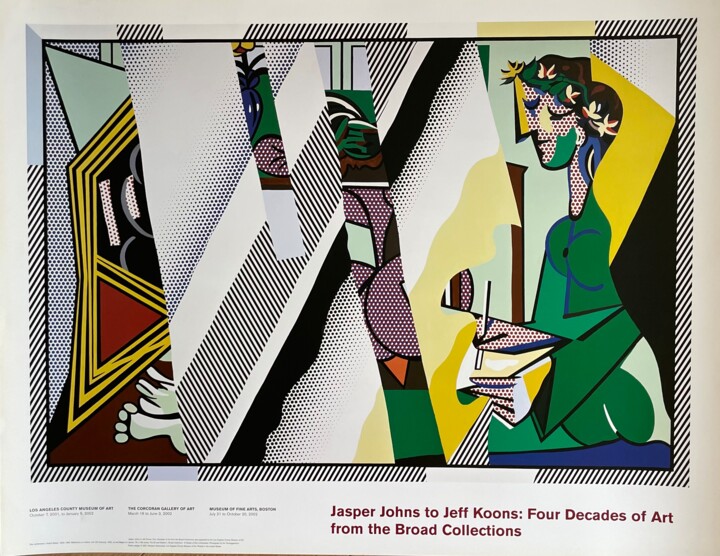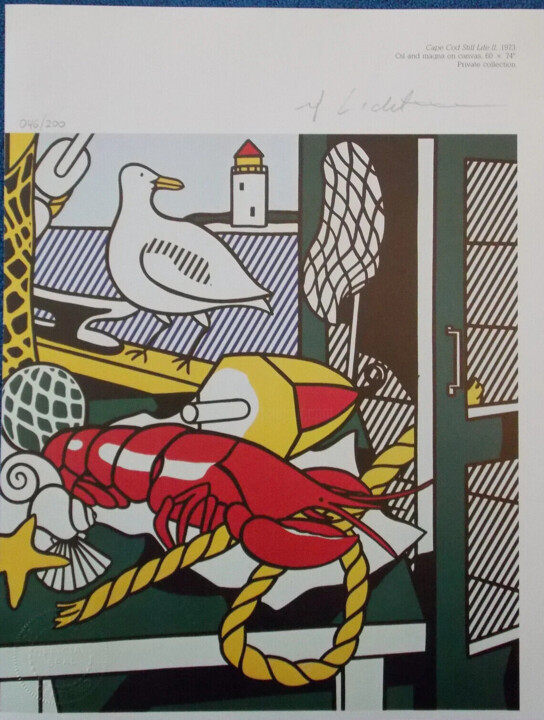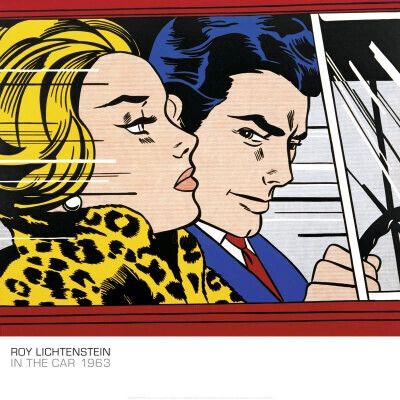 Exhibition Roy Lichtenstein in Stedelijk Museum, 1967. Author: Eric Koch, via Wikipedia
Exhibition Roy Lichtenstein in Stedelijk Museum, 1967. Author: Eric Koch, via Wikipedia
Roy Lichtenstein
Roy Fox Lichtenstein (October 27, 1923 – September 29, 1997) was a prominent American pop artist known for his bold, vibrant works that often drew inspiration from comic strips, advertisements, and popular culture. His distinctive style, characterized by the use of Ben-Day dots, thick outlines, and bright, primary colors, made him a key figure in the Pop Art movement of the 1960s.
Roy Fox Lichtenstein was born in New York City to a wealthy German-Jewish family. Lichtenstein showed an early interest in art and music, attending the Franklin School for Boys and later studying briefly at the Art Students League of New York in 1939. He went on to study at Ohio State University, where he earned a Bachelor of Fine Arts degree in 1946 after serving in the U.S. Army during World War II.
After the war, Lichtenstein returned to Ohio State to complete his master's degree and later taught there for a few years. During this period, his work was influenced by Abstract Expressionism, a dominant art movement of the time. However, his style underwent a significant transformation in the early 1960s when he began to incorporate elements of popular culture into his art.
Lichtenstein's breakthrough came in 1961 with his painting "Look Mickey," which marked the beginning of his use of comic strip imagery. He became famous for works such as "Whaam!" and "Drowning Girl", which were based on panels from comic books. These works were notable for their meticulous reproduction of the Ben-Day dot printing process, which was commonly used in commercial printing to create shading and texture.
 Roy Lichtenstein - As I Opened Fire (Triptych). Offset Lithograph. Image size: 23.75 x 19.5 in. Paper size: 25 x 62 in.
Roy Lichtenstein - As I Opened Fire (Triptych). Offset Lithograph. Image size: 23.75 x 19.5 in. Paper size: 25 x 62 in.
His technique involved painting through stencils to create the dots, mimicking the mechanical process used in mass media. This approach challenged traditional notions of fine art by blurring the lines between high and low culture, and it positioned Lichtenstein as a leading figure in the Pop Art movement alongside contemporaries such as Andy Warhol, Claes Oldenburg, and James Rosenquist.
Throughout the 1960s and 1970s, Lichtenstein continued to explore themes of consumerism, media, and art history. He produced series that reinterpreted works by artists like Picasso, Mondrian, and Monet, showcasing his versatility and deep engagement with art history. Lichtenstein's later works also included sculptures, murals, and prints, expanding his influence beyond painting.
Roy Lichtenstein's work has had a lasting impact on the art world. His ability to elevate comic book art to the realm of fine art challenged preconceived notions about artistic value and originality. He held numerous exhibitions worldwide and received many honors, including being elected to the American Academy of Arts and Letters.
Lichtenstein passed away on September 29, 1997, in New York City from pneumonia. His works continue to be celebrated and exhibited globally, and his influence can be seen in contemporary art, advertising, and popular culture. The Roy Lichtenstein Foundation, established in 1999, works to preserve and promote his legacy, ensuring that his contributions to art continue to inspire future generations.
 Roy Lichtenstein - In the car. Lithograph. Paper size: 27.5 x 27.5 in.
Roy Lichtenstein - In the car. Lithograph. Paper size: 27.5 x 27.5 in.
Comic book artistry: Lichtenstein's Whaam! and Drowning Girl
Roy Lichtenstein's ascent to fame began in the early 1960s, a transformative period for both his career and the art world. After experimenting with Abstract Expressionism and other styles, Lichtenstein's breakthrough came in 1961 with his painting "Look Mickey," which featured a comic book image of Mickey Mouse and Donald Duck. This work marked the beginning of his signature style, characterized by the use of Ben-Day dots, bold lines, and vibrant colors that mimicked the aesthetics of commercial printing.
Lichtenstein's work during this period often drew directly from comic strips and advertisements, a stark departure from the traditional subjects of fine art. His first solo exhibition at the Leo Castelli Gallery in New York in 1962 was a critical success, establishing him as a key figure in the emerging Pop Art movement. Iconic works like "Whaam!" and "Drowning Girl" followed, cementing his reputation. These paintings not only showcased his technical skill in replicating the mechanical look of printed media but also commented on the pervasive influence of mass culture
Roy Lichtenstein's painting "Whaam!" is one of his most famous pop art works, created in 1963. It is a diptych, consisting of two large canvases, and is a prime example of Lichtenstein's use of comic book imagery to make fine art. The painting is based on an image from a 1962 issue of the comic book "All American Men of War," which Lichtenstein transformed into a bold and dramatic artwork.
"Whaam!" depicts a fighter jet firing a rocket at an enemy plane, which explodes in a fiery burst. The left panel shows the jet, with the word "Whaam!" prominently displayed in a dramatic, jagged speech bubble. The right panel focuses on the explosion, emphasizing the violent impact of the rocket's strike. The use of primary colors, thick black lines, and Ben-Day dots mimics the printing techniques of comic books, creating a powerful visual effect.
Lichtenstein's work is often associated with the Pop Art movement, which emerged in the 1950s and 1960s. Pop Art sought to blur the boundaries between "high" art and "low" culture, incorporating imagery from advertising, comics, and everyday life into fine art. "Whaam!" exemplifies this approach, transforming a mundane comic book scene into a monumental and thought-provoking artwork.
"Whaam!" is held in the collection of the Tate Gallery in London. It remains a significant piece in the study of Pop Art and Lichtenstein's oeuvre, illustrating his ability to elevate popular culture to the level of fine art while commenting on themes of heroism, conflict, and mass media.
"Drowning Girl" is another iconic painting by Roy Lichtenstein, created in 1963, the same year as "Whaam!" This work is a quintessential example of Lichtenstein's style, heavily influenced by comic book art. It portrays a woman in a dramatic moment of distress, submerged in turbulent water, with a thought bubble that reads, "I don't care! I'd rather sink -- than call Brad for help!"
The painting is based on an image from the comic book series "Secret Hearts" (No. 83, 1962), specifically from a panel illustrated by Tony Abruzzo. Lichtenstein altered the original comic panel, focusing on the woman's face and the waves, and modifying the text to enhance the emotional impact.
"Drowning Girl" features Lichtenstein's characteristic use of Ben-Day dots, thick black outlines, and a limited color palette dominated by blue, black, and white. These techniques mimic the printing process of comics, creating a flat, graphic quality that emphasizes the melodramatic nature of the scene. The painting is also noted for its emotional intensity and the stark contrast between the serene beauty of the girl's face and the chaotic swirl of water around her.
This work is often interpreted as a commentary on the stereotypical portrayal of women in popular culture, particularly in romance comics of the time. Lichtenstein's use of a comic book style in a fine art context challenges traditional notions of art and highlights the influence of mass media on contemporary life.
"Drowning Girl" is housed in the collection of the Museum of Modern Art (MoMA) in New York City. It remains one of Lichtenstein's most celebrated works, embodying the essence of Pop Art by transforming a piece of popular culture into a profound and enduring artwork.
Pop Art's Brushstroke revolution
The mid-1960s to the 1970s represented the peak of Lichtenstein's career in terms of public profile and critical acclaim. During this time, he was celebrated as one of the leading artists of the Pop Art movement, alongside figures such as Andy Warhol and James Rosenquist. Lichtenstein's work was featured in major exhibitions around the world, and he received widespread media attention.
In 1964, he represented the United States at the Venice Biennale, one of the most prestigious art exhibitions in the world. His inclusion in this event signaled his acceptance and recognition by the international art community. Throughout this period, Lichtenstein continued to innovate, expanding his repertoire to include works that reinterpreted masterpieces by artists like Pablo Picasso, Claude Monet, and Henri Matisse. These reinterpretations showcased his deep engagement with art history and demonstrated his versatility as an artist.
Lichtenstein's "Brushstrokes" series from the mid-1960s, which parodied the gestural brushwork of Abstract Expressionism, further highlighted his ability to blend critique with homage. This period also saw him experimenting with sculpture, prints, and large-scale murals, broadening his artistic impact.
Unlike his earlier works that drew heavily from comic books, the "Brushstrokes" series focuses on the painterly gesture itself, a concept central to Abstract Expressionism, which dominated the art world in the decades before Lichtenstein's rise.
The series began with the painting "Brushstroke" in 1965, where Lichtenstein depicted a single, exaggerated brushstroke using his signature comic book style. This work, along with others in the series, features large, bold brushstrokes that appear to have been painted with great spontaneity and expression. However, in Lichtenstein's hands, these strokes are rendered with meticulous precision using Ben-Day dots, flat colors, and thick black outlines, mimicking the mechanical reproduction techniques of printed comics.
Lichtenstein's "Brushstrokes" series is a playful and ironic commentary on the Abstract Expressionist movement, which celebrated the emotive and personal nature of the artist's brushstroke. By transforming these expressive marks into stylized, cartoon-like images, Lichtenstein challenges the romantic notion of the heroic artist and the authenticity of painterly gestures. The series highlights the tension between mass production and individuality, a recurring theme in Pop Art.
The "Brushstrokes" series includes various paintings, prints, and sculptures, each emphasizing different aspects of the brushstroke motif. Notable works in the series are "Big Painting No. 6" (1965), "Little Big Painting" (1965), and "Yellow and Green Brushstrokes" (1966). Each piece underscores Lichtenstein's ability to blend high art with popular culture, questioning the boundaries of artistic expression.
Lichtenstein's later works
By the 1970s, Roy Lichtenstein had firmly established himself as a major figure in contemporary art. His works were collected by major museums and private collectors, and he received numerous honors and awards. Lichtenstein's influence extended beyond the art world, impacting advertising, graphic design, and popular culture.
During a visit to Los Angeles in 1978, Roy Lichtenstein was captivated by lawyer Robert Rifkind's collection of German Expressionist prints and illustrated books. This encounter inspired him to incorporate stylistic elements from Expressionist paintings into his own works, for example "The White Tree" (1980). Lichtenstein used small colored-pencil drawings as templates for woodcuts, a technique favored by artists like Emil Nolde, Max Pechstein, Dix, and Ernst Ludwig Kirchner.
In the late 1970s, Lichtenstein's style evolved towards more surrealistic works, such as "Pow Wow" (1979). He embarked on a significant series of Surrealist-Pop paintings from 1979 to 1981, centered around Native American themes. These artworks ranged from pieces like "Amerind Figure", a streamlined, life-size sculpture in black-patinated bronze resembling a totem pole, to the monumental wool tapestry "Amerind Landscape". The "Indian" series drew inspiration from contemporary art and sources such as books on American Indian design from Lichtenstein's personal library, continuing his exploration of hybrid Surrealist-Pop motifs.
Lichtenstein's Still Life artworks, spanning from 1972 to the early 1980s, encompass a range of subjects including traditional motifs such as fruit, flowers, and vases. In 1983, he created two posters titled "Against Apartheid", reflecting his stance on the issue. His Reflection series, produced from 1988 to 1990, revisits and reinterprets motifs from his earlier works. The Interiors series (1991–1992) portrays everyday domestic scenes inspired by furniture advertisements found in telephone books and billboards.
Inspired by monochromatic prints by Edgar Degas exhibited at the Metropolitan Museum of Art in 1994, Lichtenstein's Landscapes in the Chinese Style series features motifs created using simulated Ben-Day dots and bold block contours, characterized by vivid colors and a deliberate lack of visible brushstrokes. The nude figure also recurs in Lichtenstein's art of the 1990s, as seen in works like "Collage for Nude with Red Shirt" (1995).
His ability to transform mundane, everyday imagery into high art challenged traditional hierarchies and redefined what could be considered art. Andy Warhol and Roy Lichtenstein revolutionized the art world through their iconic Pop Art creations in the 1960s. Warhol's fascination with mass production and celebrity culture and Lichtenstein's use of comic book imagery and bold colors both challenged traditional artistic conventions, making them pivotal figures in modern art history.


 Selena Mattei
Selena Mattei

